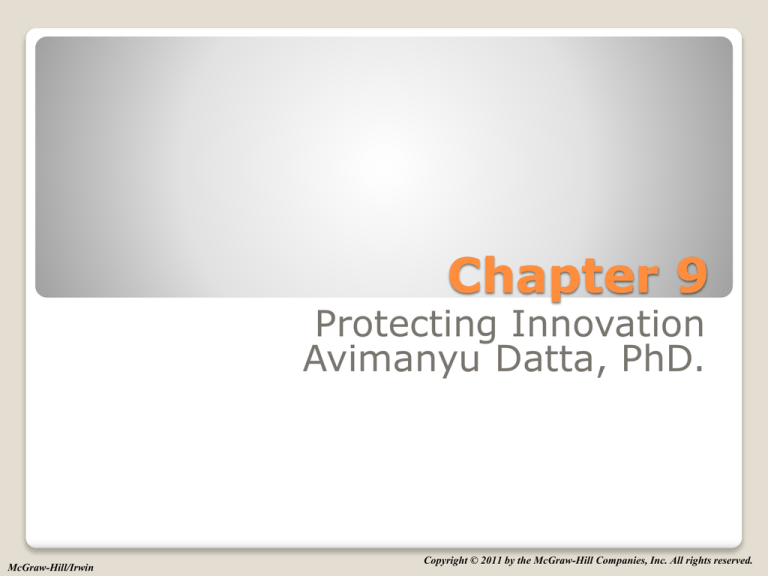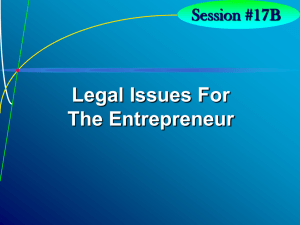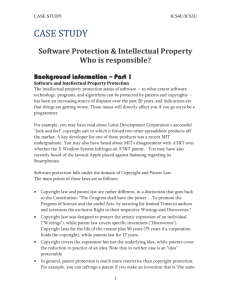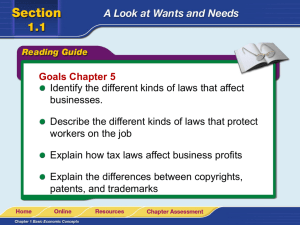
Chapter 9
Protecting Innovation
Avimanyu Datta, PhD.
McGraw-Hill/Irwin
Copyright © 2011 by the McGraw-Hill Companies, Inc. All rights reserved.
Overview
Firms
must decide whether and how to
protect their technological innovations.
Protecting
innovation helps a firm retain
control over it and appropriate the rents
from it.
However,
sometimes not protecting a
technology is to the firm’s advantage – it
may encourage others to support the
technology and increase its likelihood of
becoming dominant.
Appropriability
Appropriability:
The degree to which a firm
is able to capture the rents from its
innovation.
◦ Appropriability is determined by how easily or
quickly competitors can copy the innovation.
Some innovations are inherently difficult to copy
(tacit, socially complex, etc.)
Firms may also attempt to protect innovations
through patents, trademarks, copyrights or trade
secrets.
Patents, Trademarks and Copyrights
Patents, trademarks and copyrights each protect
different things.
◦ Patents: rights granted by the government that excludes
others from producing, using, or selling an invention.
◦ Must be useful, novel, and not be obvious.
Utility patents protect new and useful processes, machines,
manufactured items or combination of materials.
Design patents protect original and ornamental designs for
manufactured items.
Plant patents protect distinct new varieties of plants.
◦ In 1998, many software algorithms became eligible for
patent protection.
Patents, Trademarks and Copyrights
The patent process can take 2-5 years, and involves a number of costs.
Fee Types ($US)
Regular Fee Small Entity Fee
Patent Filing Fees
Basic patent filing fee—Utility
$330
$165
Search Fee—Utility
540
270
Examination Fee—Utility
220
110
Basic patent filing fee—Design
220
110
Search Fee—Design
100
50
Examination Fee—Design
140
70
Patent filing fee—Plant
220
110
Search Fee—Plant
330
165
Examination Fee—Plant
170
85
Patent Post-Allowance Fees (paid after Patent Office approves patent)
Utility patent issue fee
$1,510
$755
Design patent issue fee
860
430
Plant patent issue fee
1,190
595
Publication fee
300
300
Patents, Trademarks and Copyrights
Patent Laws Around the World
◦ Countries have their own laws regarding patent protection.
Some treaties seek to harmonize these laws.
Paris Convention for the Protection of Industrial Property
◦ Foreign nationals can apply for the same patent rights in each member
country as that country’s own citizens.
◦ Provides right of “priority” – once inventor has applied for protection in
one member country, they can (within certain time period) apply for
protection in others and be treated as if they had applied on same date
as first application.
Patent Cooperation Treaty (PCT)
◦ Inventor can apply for patent in a single PCT receiving office and
reserve right to apply in more than 100 countries for up to 2 ½ years.
Establishes date of application in all member countries simultaneously.
Also makes results of patent process more uniform.
Patents, Trademarks and Copyrights
Countries that are members of Patent
Cooperation Treaty
PCT Covered
countries
Non-PCT Covered
countries
Patents, Trademarks and Copyrights
◦ Trademarks and Service Marks: a word, phrase,
symbol, design, or other indicator that is used to
distinguish the source of goods form one party from goods
of another (e.g., Nike “swoosh” symbol)
Rights to trademark are established in legitimate use of mark; do
not require registration.
However, marks must be registered before suit can be brought
over use of the mark.
Registration can also be used to establish international rights
over trademark.
◦ Two treaties simplify registration of trademarks in multiple
countries: Madrid Agreement Concerning the
International Registration of Marks, and the Madrid
Protocol. Countries that adhere to either or both are in
Madrid Union (84 members)
Patents, Trademarks and Copyrights
◦ Copyright: a form of protection granted to works of
authorship.
Copyright prohibits others from:
◦ Reproducing the work in copies or phonorecords
◦ Preparing derivative works based on the work
◦ Distributing copies or phonorecords for sale, rental, or lease
◦ Performing the work publicly
◦ Displaying the work publicly
Work that is not fixed in tangible form is not eligible.
Copyright is established in first legitimate use.
However, “doctrine of fair use” stipulates that others can typically
use copyrighted material for purposes such as criticism, new
reporting, teaching research, etc.
Copyright for works created after 1978 have protection for
author’s life plus 70 years.
Patents, Trademarks and Copyrights
Copyright
Protection Around the World
◦ Copyright law varies from country to country.
◦ However, the Berne Union for the Protection of
Literary and Artistic Property (“Berne
Convention”) specifies a minimum level of
protection for member countries.
◦ Berne convention also eliminates differential rights
to citizens versus foreign nationals.
Trade Secrets
Trade Secret: information that belongs to a
business that is generally unknown to others.
◦ Firm can protect proprietary product or process as trade
secret without disclosing detailed information that would be
required in patent.
◦ Enables broad class of assets and activities to be protectable.
◦ To qualify:
Information must not be generally known or ascertainable.
Information must offer a distinctive advantage to the firm that is
contingent upon its secrecy.
Trade secret holder must exercise reasonable measures to protect
its secrecy.
The Effectiveness and Use of
Protection Mechanisms
In some industries, legal protection mechanisms are
more effective than others
◦ E.g., in pharmaceutical patents are powerful; in electronics
they might be easily invented around.
It is notoriously difficult to protect manufacturing
processes and techniques.
In some situations, diffusing a technology may be
more valuable than protecting it.
However, once control is relinquished it is difficult to
reclaim.
Theory In Action
IBM and the Attack of the Clones
In 1980, IBM was in a hurry to introduce a personal
computer (PC). It used off-the-shelf components such as
Intel microprocessors an operating system from Microsoft,
MS DOS.
It believed that its proprietary basic input/output system
(BIOS) would protect the computer from being copied.
However, Compaq reverse engineered the BIOS in a matter
of months without violating the copyright, and quickly
introduced a computer that behaved like an IBM computer in
every way. Compaq sold a record-breaking 47,000 IBMcompatible computers its first year, and other clones were
quick to follow.
The Effectiveness and Use of
Protection Mechanisms
Wholly Proprietary Systems vs. Wholly Open Systems
◦ Wholly proprietary systems may be legally produced or augmented only by
their developers.
◦ Wholly open system may be freely accessed, augmented and distributed by
anyone.
◦ Many technologies lie somewhere between these extremes.
The Effectiveness and Use of
Protection Mechanisms
◦ Advantages of Protection
Proprietary systems offer greater rent appropriability.
Rents can be used to invest in further development,
promotion, and distribution.
Give the firm control over the evolution of the
technology and complements
◦ Advantages of Diffusion
May accrue more rapid adoptions if produced and
promoted by multiple firms
Technology might be improved by other firms (though
external development poses its own risks).
The Effectiveness and Use of
Protection Mechanisms
Production Capabilities, Marketing Capabilities,
and Capital
◦
Factors influencing benefits of protection vs. diffusion
1. Can firm produce the technology at sufficient volume or quality levels?
2. Are complements important? Are they available in sufficient range and
quality? Can the firm afford to develop and produce them itself?
3. Is there industry opposition against sole source technology?
4. Can the firm improve the technology well enough and fast enough to
compete with others?
5. How important is it to prevent the technology from being altered in ways that
fragment it as a standard?
6. How valuable is architectural control to the firm? Does it have a major stake
in complements for the technology?
Theory in Action
Sun Microsystems and Java
In 1995, Sun developed a software programming language called Java
that enabled programs to be run on any operating system (e.g.,
Windows, Macintosh). This would lessen pressure for one operating
system to be dominant.
Members of the software community felt that Sun should make Java
completely “open” – they argued that “Java is bigger than any one
company.”
However, Sun was afraid that if Java were completely open, companies
would begin to customize it in ways that would fragment it as a
standard.
Sun decided to distribute Java under a “community source” program: no
license fees, but all modifications to Java required compatibility tests
performed by Java’s own standards body.
The Digital Music Distribution
Revolution
In 1991, Fraunhofer IIS of Germany invents the MP3 format; by late 1990’s the
format is wildly popular.
In 1999, Shawn Fanning releases Napster, a free software program that allows
users to easily share MP3 files (“peer-to-peer”)
The RIAA starts to worry about illegal trade of copyrighted music. In 2001 it
gets a court ruling against Napster, taking it offline.
However, new peer-to-peer music services began to sprout up to meet the
demand of the large population of “music pirates.”
In 2003, Apple opens its iTunes Music Store – a one-stop-shop for music files
from the five major record labels. Now record industry is earning significant
revenues from MP3s.
In 2006, France pushes Apple to loosen its restrictions on iTunes music and
iPods. Should Apple use a more “open” model?
Meanwhile, new models of digital distribution were emerging: Creative
Commons (license agreements to make files public, legal, and free), and
“Podcasting” (whereby whole “shows” could be downloaded).
The Digital Music Distribution
Revolution
Discussion Questions:
1.
What industry conditions lead to the revolution in audio distribution?
Which stakeholders stand to benefit most (or least) from this
revolution?
2. Why did the music stores created by the record labels fail to attract
many subscribers? What, if anything, should the record labels have
done differently?
3. What will determine how long the success of the iPod and iTunes
endures? Should Apple allow its iPods to play non-iTunes songs?
Should Apple allow iTunes songs to play on non-iPod MP3 players?
4. Why would musicians sign away their copyright privileges to their
songs through “Creative Commons”?
5. How is podcasting likely to impact the appropriability of recorded
music, radio broadcasting, or other types of audio transmissions?
Discussion Questions
1. What
are the differences between patents, copyrights, and
trademarks?
2. Consider a firm that is considering marketing its innovation in
multiple countries. What factors should this firm consider in
formulating its protection strategy?
3. When will trade secrets be more useful than patents, copyrights or
trademarks?
4. Can you identify a situation in which none of the legal protection
mechanisms discussed (patents, copyrights, trademarks, trade
secrets) will prove useful?
5. Describe a technological innovation not discussed in the chapter, and
identify where you think it lies on the control continuum between
wholly proprietary and wholly open.
6. What factors do you believe influenced the choice of protection
strategy used for the innovation identified above? Do you think the
strategy was a good choice?
Part Three: Implementing
Technological Innovation Strategy
Structuring the firm to improve its likelihood of innovating, its
effectiveness at new product development, and its speed of new
product development,
Managing new product development processes to maximize fit
with customer needs, while simultaneously minimizing
development cycle time and controlling development costs,
Composing, structuring, and managing new product
development teams to maximize new product development
effectiveness,
Crafting a strategy for effectively deploying the innovation into
the marketplace, including timing, licensing strategies, pricing
strategies, distribution, and marketing.





